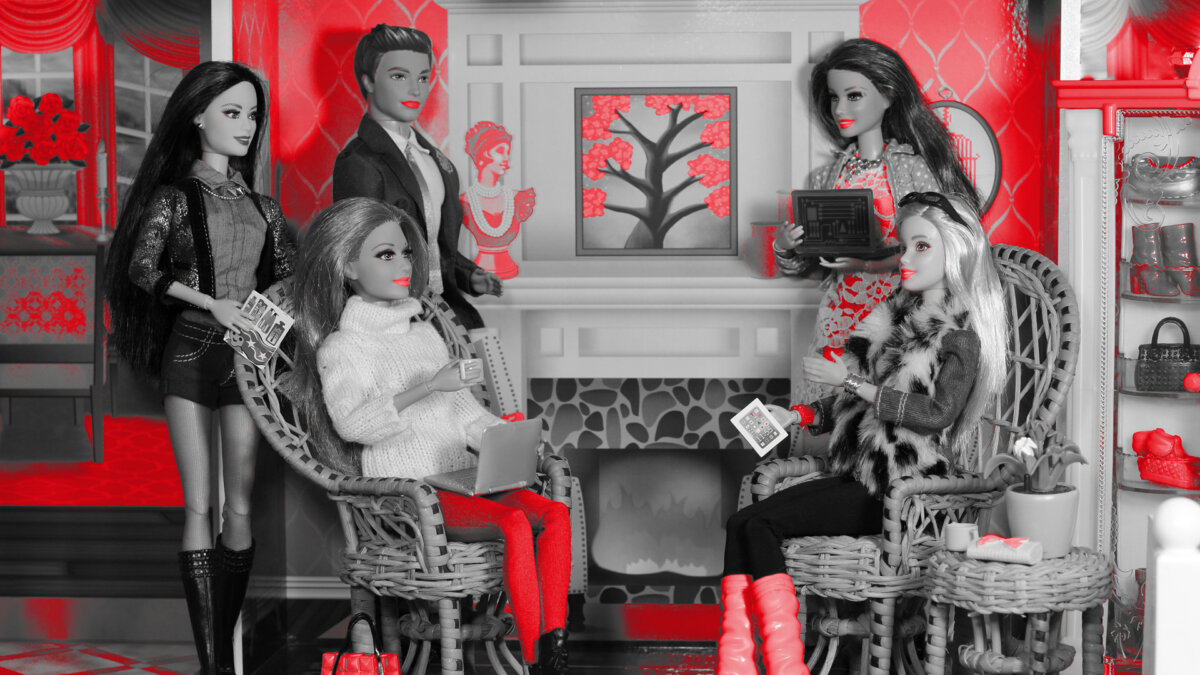Barbie is one of the few toys that have survived the test of time. Think back to your own childhood - what remains of the toys of that time? The answer is probably: "Not much". Except, it seems, Barbie. There is obviously a recipe for success in marketing this doll that has stood the test of time and ensures that children still want her in their lives.
This summer we are all "Barbie Girls living in a Barbie World". Before the release of the Greta Gerwig-directed film, a marketing campaign about the size of the cult doll's ever-expanding wardrobe bathed the whole world in bright pink. The most popular doll and her cohorts were encountered almost everywhere: there were billboards and cosmetic products, fashion collaborations and frozen yoghurt, trailers and TikTok trends.
Barbie's dream house came to life in an HGTV renovation show, while Airbnb rented out a separate magenta mansion. A Barbie boat docked in Boston harbour for a neon party. The contestants of ABC's show The Bachelorette wore outfits inspired by Ken in a special episode.
"They have pushed intellectual property to the limit," said Moshe Isaacian, a brand strategist who led the brand's marketing efforts in a Twitter thread which has since gone viral. "You get the feeling that almost every part of Barbie and her universe has been brought to life."
The power of marketing
The full "Barbiefication" in 2023 comes at a crucial time for the world's leading doll brand, which underwent a successful rebrand in the late 2010s but has seen declining sales in recent quarters.
With a glamorous marketing campaign and various viral trends designed to increase Barbie's chances of success, all signs point to the film being a huge success. The unique malleability, "shoppability" and Instagram-ability of the Barbie brand have given the iconic doll the power to make potential moviegoers want to dress in pink. "This is a marketing campaign that is bigger than the movie itself," Paul Dergarabedian, senior media analyst at Comscore, told Marketing Brew.
But the film is not the only one to boast brilliant marketing. The brand's success story is an impressive demonstration of effective marketing strategies that have made the toy a timeless cult object. Since its launch in 1959, Barbie has captured the hearts of millions of children and collectors and has become one of the best-known and most successful toy brands in the world. Here are some of the key marketing strategies that have contributed to this doll's unprecedented success story:
- Innovative product development: The introduction of Barbie as a "Teenage Fashion Model" was a groundbreaking idea in her time. She was the first fashion doll to be customisable with changeable outfits and accessories. Mattel, the company behind Barbie, constantly introduced new doll models and themed sets to stimulate children's imaginations and keep them interested. While most brands are popular for only two or three years, the brand's long-term success reflects Mattel's responsiveness and adaptability to changing cultural and political discourses in society.
- Strong brand identity: Barbie has built a unique and consistent brand identity. The blonde hair, bright smile and perfect physique gave her an unmistakable appearance that is firmly anchored in the minds of consumers.
- Emotionality and storytelling: Mattel has managed to create an emotional connection between the brand and its customers by developing stories and backgrounds for the Barbie doll. Their world includes different actors, professions, hobbies and roles that allow children to live out their dreams and fantasies. The storylines and individual characteristics of the additional characters connect with Barbie's personality and increase the visibility of the brand.
- Strong TV and print advertising: The interesting thing about Barbie is that she was one of the first toys to use television advertising as her main marketing strategy. Mattel has run a variety of advertising campaigns on television and print media over the past few decades to promote Barbie. The ads often show her in different scenarios, giving fans a glimpse of the myriad possibilities the doll offers.
- Targeted influencer marketing: Mattel has successfully collaborated with celebrity influencers to showcase Barbie on social media and increase brand awareness. By addressing modern trends and issues, she remains relevant in the digital era.
- Cooperations and licensing: The brand has expanded through partnerships with other well-known brands and franchises. One of the most famous examples of this was the cooperation with Disney, which created limited editions. Another example is this year's film adaptation by Warner Bros to immortalise the immortal brand on the big screen.
- Diversity and inclusion: In recent years, Mattel has begun to promote diversity and inclusion in the Barbie world by introducing dolls with different skin colours, body types and backgrounds. This has made the brand even more relevant and appealing to a wider audience.
- Dedicated fan base: The Barbie brand has built a dedicated fan base interested in collecting and sharing Barbie dolls and accessories. This community plays an important role in spreading enthusiasm for the brand.
In summary, the brand owes its success to a combination of innovative product development, emotional connection, effective advertising campaigns, diverse and inclusive messaging, and a dedicated fan base. By continuously evolving and adapting to ever-changing times, Barbie remains a fascinating and beloved toy brand that has delighted generations of children and will hopefully continue to do so in the future.
Barbie goes Marketing
The success story of the Barbie brand impressively shows the decisive importance of marketing for the triumph of a brand. Through targeted investments in marketing, Mattel has made Barbie a worldwide phenomenon. Yet marketing is far more than just advertising and promotion - it is the key to shaping a brand, keeping it relevant and creating a lasting connection with customers. By 2018, Mattel had seen several years of declining global sales, with annual net sales falling from $6.5 billion to $4.5 billion between 2013 and 2018 (Statista). Ynon Kreiz, CEO of Mattel, recognised the need for change and launched a series of innovative marketing campaigns to revitalise the brand and reverse the company's decline.
This example clearly shows that companies that cut marketing spending risk losing customers and market share. In fact, companies that invest in marketing during a downturn often emerge stronger, while companies that cut marketing spending can struggle to get back on their feet. This is true for both the B2B and B2C sectors.

What can B2B learn from Barbie?
Barbie's success story offers valuable lessons that can also be applied in the B2B marketing can be applied. Innovation is a key competitive advantage. Just as Barbie is constantly introducing new models and sets, B2B companies should also continuously evolve their offerings to meet changing customer demands. A strong brand identity that reflects a company's values, mission and uniqueness is equally important to stand out from the competition.
Storytelling can be used to create an emotional connection with customers, whether through sharing customer success stories or showcasing the company's history and values. Influencer marketing, in the form of partnerships with industry experts or satisfied customers, can increase credibility and expand reach.
Partnerships with other companies or industries can open up new markets and expand the offering, much like Barbie did by partnering with Disney and Warner Bros. B2B companies should also ensure that their marketing messages and materials take into account a diversity of perspectives and experiences and are accessible to all.
Finally, customer retention is an important aspect that can be achieved by building strong customer relationships and providing excellent customer experiences. These adaptations of Barbie marketing strategies can help B2B marketers improve their marketing efforts and enhance the success of their Brand increase.
Pimp your brand
Studies show that there are many ways to build and maintain a brand in the long term. From a clear Brand identity and consistent brand messages to the targeted use of Social media and influencer marketing, the spectrum of strategies ranges. For laypeople, however, this diversity can often seem confusing and complicated. The challenge is to select the right approaches and implement them effectively to achieve the desired effect. This is where the expert know-how of a marketing agency is needed.
With our comprehensive knowledge and expertise we help companies build a strong brand identity and create an emotional connection with their customers. Because we firmly believe that a well thought-out and effective marketing strategy is the key to your brand's success - just like Barbie.






